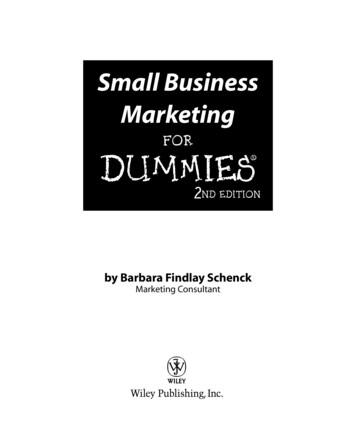
Transcription
Small BusinessMarketingFORDUMmIES‰2NDEDITIONby Barbara Findlay SchenckMarketing Consultant
Small Business Marketing For Dummies , 2nd EditionPublished byWiley Publishing, Inc.111 River St.Hoboken, NJ 07030-5774www.wiley.comCopyright 2005 by Wiley Publishing, Inc., Indianapolis, IndianaPublished simultaneously in CanadaNo part of this publication may be reproduced, stored in a retrieval system, or transmitted in any form or byany means, electronic, mechanical, photocopying, recording, scanning, or otherwise, except as permittedunder Sections 107 or 108 of the 1976 United States Copyright Act, without either the prior written permission of the Publisher, or authorization through payment of the appropriate per-copy fee to the CopyrightClearance Center, 222 Rosewood Drive, Danvers, MA 01923, 978-750-8400, fax 978-646-8600. Requests tothe Publisher for permission should be addressed to the Legal Department, Wiley Publishing, Inc., 10475Crosspoint Blvd., Indianapolis, IN 46256, 317-572-3447, fax 317-572-4355, e-mail: brandreview@wiley.com.Trademarks: Wiley, the Wiley Publishing logo, For Dummies, the Dummies Man logo, A Reference for theRest of Us!, The Dummies Way, Dummies Daily, The Fun and Easy Way, Dummies.com, and related tradedress are trademarks or registered trademarks of John Wiley & Sons, Inc., and/or its affiliates in the UnitedStates and other countries, and may not be used without written permission. All other trademarks are theproperty of their respective owners. Wiley Publishing, Inc., is not associated with any product or vendormentioned in this book.LIMIT OF LIABILITY/DISCLAIMER OF WARRANTY: THE PUBLISHER AND THE AUTHOR MAKE NO REPRESENTATIONS OR WARRANTIES WITH RESPECT TO THE ACCURACY OR COMPLETENESS OF THECONTENTS OF THIS WORK AND SPECIFICALLY DISCLAIM ALL WARRANTIES, INCLUDING WITHOUTLIMITATION WARRANTIES OF FITNESS FOR A PARTICULAR PURPOSE. NO WARRANTY MAY BE CREATED OR EXTENDED BY SALES OR PROMOTIONAL MATERIALS. THE ADVICE AND STRATEGIES CONTAINED HEREIN MAY NOT BE SUITABLE FOR EVERY SITUATION. THIS WORK IS SOLD WITH THEUNDERSTANDING THAT THE PUBLISHER IS NOT ENGAGED IN RENDERING LEGAL, ACCOUNTING, OROTHER PROFESSIONAL SERVICES. IF PROFESSIONAL ASSISTANCE IS REQUIRED, THE SERVICES OF ACOMPETENT PROFESSIONAL PERSON SHOULD BE SOUGHT. NEITHER THE PUBLISHER NOR THEAUTHOR SHALL BE LIABLE FOR DAMAGES ARISING HEREFROM. THE FACT THAT AN ORGANIZATIONOR WEBSITE IS REFERRED TO IN THIS WORK AS A CITATION AND/OR A POTENTIAL SOURCE OF FURTHER INFORMATION DOES NOT MEAN THAT THE AUTHOR OR THE PUBLISHER ENDORSES THEINFORMATION THE ORGANIZATION OR WEBSITE MAY PROVIDE OR RECOMMENDATIONS IT MAYMAKE. FURTHER, READERS SHOULD BE AWARE THAT INTERNET WEBSITES LISTED IN THIS WORKMAY HAVE CHANGED OR DISAPPEARED BETWEEN WHEN THIS WORK WAS WRITTEN AND WHEN ITIS READ.For general information on our other products and services, please contact our Customer CareDepartment within the U.S. at 800-762-2974, outside the U.S. at 317-572-3993, or fax 317-572-4002.For technical support, please visit www.wiley.com/techsupport.Wiley also publishes its books in a variety of electronic formats. Some content that appears in print maynot be available in electronic books.Library of Congress Control Number: 2004117340ISBN: 0-7645-7839-1Manufactured in the United States of America1098762O/RY/QR/QV/IN54321
About the AuthorBarbara Findlay Schenck built her career matching products to markets,which is what marketing — and what this book — is all about.Her involvement in the field began in the University of Oregon public relationsoffice, where she developed an interest in marketing that she has followed literally around the world. She graduated with a degree in English from OregonState University and immediately moved to Hawaii, where she became director of admissions and instructor of writing at a small private college on Oahubefore joining the staff of Honolulu’s largest public relations firm.In 1978 she and her husband, Peter, left Hawaii for a village on the South ChinaSea, where for two years they managed a development program for the PeaceCorps in Malaysia.In 1980, they returned to their home state of Oregon and founded an advertising agency, attracting a clientele that included ski and golf resorts, banks,apparel and equipment manufacturers, the state’s tourism, lottery, and jobtraining divisions, and a good number of small and larger-sized businessesthat provided the wealth of hands-on experience reflected in this book.In 1995, they sold the agency and moved with their son to Italy, where Barbarabegan work on several book projects. In 2000, she co-wrote Portraits of Guilt,the Edgar Award-nominated memoir of internationally recognized criminalinvestigative artist Jeanne Boylan. In 2001, she authored the first edition ofSmall Business Marketing For Dummies, which Business Week praised for presenting “marketing issues as real-world problems with real-world solutions.”Today, she’s still forming her thoughts into headlines, news releases, andmarketing plans, but on a more relaxed schedule. In addition to writing, sheoffers marketing presentations and workshops. Contact her by writingBFSchenck@aol.com.
Author’s AcknowledgmentsAs I finish this second, updated edition of Small Business Marketing ForDummies, my gratitude reaches back to all those who helped bring the bookinto existence the first time round, and it spins forward to the current longlist of those who helped me overhaul the contents to incorporate the rapidfire changes that affect today’s business world.As in the first edition, my greatest thanks goes to Peter, my husband, collaborator, and best friend, and to our son Matthew, who bails me out with computer advice and, increasingly, with marketing wisdom gleaned from his ownascent in the business world.My longtime and treasured business associates and friends Kathy DeGree andMeaghan Ryan Houska win heaps of appreciation for the resources, perspective, and enthusiasm they’ve shared throughout this and every other projectwe’ve undertaken together.Revising this book to address the technical realities of today’s world requiredcurrent, hands-on expertise, and I am deeply indebted to our hometownnewspaper, The Bulletin, for providing help without limit as I prepared thechapters on media buying and public relations. Likewise, I’m grateful to theteam at Alpine Internet Solutions who shared hours reviewing the online marketing advice included in Chapter 16.Brad Hill, author of Building Your Business with Google For Dummies didn’tthink twice before responding to my call for help. The same is doubly true forJim Schell, author of Small Business For Dummies, with whom I’m fortunate towork on an ongoing basis.In the first edition I wrote that my book’s editorial team, led by editor NormCrampton, “would make any author wish for an encore performance.” Thisedition is proof that wishes come true. This time, thanks goes to AcquisitionsEditor Kathy Cox (a champion), Project Editor Corbin Collins (I still can’tbelieve my luck that someone with his talent edited this book), and TechnicalReviewer Kimberly McCall, the Marketing Angel referred to us by the wonderful editors at Entrepreneur magazine.Finally and most sincerely, my gratitude in life begins and ends with my parents, Walt and Julie Findlay, and the best three sisters ever put on this earth.Thank you all.
Publisher’s AcknowledgmentsWe’re proud of this book; please send us your comments through our Dummies online registrationform located at www.dummies.com/register/.Some of the people who helped bring this book to market include the following:Acquisitions, Editorial, andMedia DevelopmentCompositionProject Editor: Corbin Collins(Previous Edition: Norm Crampton)Acquisitions Editor: Kathy CoxCopy Editor: Corbin CollinsProject Coordinator: Adrienne MartinezLayout and Graphics: Lauren Goddard,Barry Offringa, Lynsey Osborn,Melanee Prendergast, Jacque Roth,Julie Trippetti, Mary Gillot VirginTechnical Editor: Kimberly L. McCallProofreaders: Leeann Harney,Jessica Kramer, Carl William Pierce,TECHBOOKS Production ServicesEditorial Manager: Carmen KrikorianIndexer: TECHBOOKS Production ServicesAssistant Editor: Holly Gastineau-GrimesEditorial Assistants: Courtney Allen,Nadine BellCartoons: Rich Tennant, www.the5thwave.comPublishing and Editorial for Consumer DummiesDiane Graves Steele, Vice President and Publisher, Consumer DummiesJoyce Pepple, Acquisitions Director, Consumer DummiesKristin A. Cocks, Product Development Director, Consumer DummiesMichael Spring, Vice President and Publisher, TravelBrice Gosnell, Associate Publisher, TravelKelly Regan, Editorial Director, TravelPublishing for Technology DummiesAndy Cummings, Vice President and Publisher, Dummies Technology/General UserComposition ServicesGerry Fahey, Vice President of Production ServicesDebbie Stailey, Director of Composition Services
Contents at a GlanceIntroduction .1Part I: Getting Started in Marketing .5Chapter 1: A Helicopter View of the Marketing Process .7Chapter 2: All About Customers.17Chapter 3: Seeing Your Product through Your Customers’ Eyes .33Chapter 4: Sizing Up Competitors and Staking Out Market Share .49Chapter 5: Goals, Objectives, Strategies, and Budgets .61Part II: Sharpening Your Marketing Focus .73Chapter 6: Projecting the Right Image .75Chapter 7: Establishing Your Position and Brand .89Chapter 8: Getting Strategic before Getting Creative .103Chapter 9: Hiring Help for Your Marketing Program .113Part III: Creating and Placing Ads .133Chapter 10: Mastering Advertising Basics and Media Planning .135Chapter 11: Creating Print Ads .155Chapter 12: Broadcasting Ads on Radio and TV .173Part IV: Getting the Word Out without Advertising .189Chapter 13: Mailing Direct to Your Market .191Chapter 14: Brochures, Promotions, Trade Shows, and More .211Chapter 15: Public Relations and Publicity .231Chapter 16: Tapping the Internet’s Marketing Power .247Part V: Winning and Keeping Customers .273Chapter 17: Making the Sale .275Chapter 18: Enhancing Customer Service .289Chapter 19: Fortifying Customer Relationships .303Part VI: The Part of Tens .317Chapter 20: Ten Questions to Ask Before You Choose a Name .319Chapter 21: Ten Ideas to Embrace and Ten to Avoid .325Chapter 22: Ten Steps to a Great Marketing Plan .331Appendix: Where to Find More Information .337Index .341
Table of ContentsIntroduction.1How to Know That This Book Is for You .1How to Use This Book .2How This Book Is Organized .2Part I: Getting Started in Marketing .2Part II: Sharpening Your Marketing Focus .3Part III: Creating and Placing Ads .3Part IV: Getting the Word Out without Advertising .3Part V: Winning and Keeping Customers .3Part VI: The Part of Tens .4Icons Used in This Book .4Ready, Set, Go! .4Part I: Getting Started in Marketing .5Chapter 1: A Helicopter View of the Marketing Process . . . . . . . . . . .7Seeing the Big Picture .8The marketing wheel of fortune .8Marketing and sales are not synonymous .9Jumpstarting Your Marketing Program .10Marketing a start-up business .11Marketing to grow your business .12Scaling your program to meet your goal .12How Small Business Marketing Is Different .13Dollar differences .13Staffing differences .13Creative differences .13Strategic differences .14The small business marketing advantage .14Making Marketing Your Key to Success .15Chapter 2: All About Customers . . . . . . . . . . . . . . . . . . . . . . . . . . . . . . . .17Anatomy of a Customer .18Collecting information about your customer .18Geographics: Locating your market areas .22Demographics: Collecting data to define your market .23Psychographics: Customer buying behaviors .24Using customer profiles to guide marketing decisions .26Determining Which Customers Buy What .26Viewing your sales by market segment .27Tracing your distribution channels .29
xivSmall Business Marketing For Dummies, 2nd EditionChapter 3: Seeing Your Product through Your Customers’ Eyes . . . .33In a Service Business, Service Is the Product .34Telling “Just the Facts” about What You Sell .34Tallying your sales by product line .35Using the cash register to steer your business .36Illogical, Irrational, and Real Reasons People Buy What You Sell .37Buying Decisions Are Rarely about Price, Always about Value .38The value formula .38Riding the price/value teeter-totter .40Pricing considerations .41Presenting prices .41The Care and Feeding of Your Product Line .43Enhancing the appeal of existing products .44Even products have life cycles .45Raising a healthy product .45Developing new products .46Chapter 4: Sizing Up Competitors and Staking Out Market Share . . .49Playing the Competitive Field .50The terminology of competition .50Knowing what you’re up against .52How businesses compete .53Winning Your Share of the Market .53Defining your direct competition .54Moving up the competitive ladder .55Calculating Your Market Share .56Sizing up your target market .56Doing the math .57Increasing Your Market Share .59Chapter 5: Goals, Objectives, Strategies, and Budgets . . . . . . . . . . . .61Where Are You Going, Anyway? .62The “vision” thing .62Developing your statement of purpose .63Success stories .63Goals and Objectives Defined Simply .64Setting goals and objectives .65Setting strategies .66Goals, objectives, and strategies in action .66The failsafe planning sequence .68Budgeting to Reach Your Goals .68Realistic talk about small business marketing budgets .68How much should you be spending? .69Budgeting considerations .70Why a static budget is headed downhill .71
Table of ContentsPart II: Sharpening Your Marketing Focus .73Chapter 6: Projecting the Right Image . . . . . . . . . . . . . . . . . . . . . . . . . .75Making First Impressions .75Arriving by telephone .76Approaching your business in person .78Online encounters .82Creating an Impression Inventory .85Rating Your Marketing Communications .87Chapter 7: Establishing Your Position and Brand . . . . . . . . . . . . . . . . .89Brands Live in the Minds of Customers .90You can have a powerful brand without having a power brand .90Consistency builds brands .91Branding makes selling easier .91An essential online ingredient .92Six steps to brand management .92Filling a Meaningful Market Position .94How positioning happens .94Determining your positioning strategy .95Conveying Your Position and Brand through Tag Lines .96Advancing Your Brand through a Creative Strategy .98Writing your creative strategy .98Using your creative strategy .99Writing Your Image Style Guide .99Controlling your logo presentation .100Deciding on your type style .100Copy guidelines .101Chapter 8: Getting Strategic before Getting Creative . . . . . . . . . . . .103Good Communications Start with Good Objectives .103Putting an end to shot-in-the-dark marketing instructions .104Dodging the creative landmines .104Deciding on a Goal for Every Single Marketing Communication .105Writing a Creative Brief .105Targeting your market .106Dealing with prospect perceptions .107Stating your desired outcome .107Conveying benefits versus features .109Naming your “have-to-haves” .110Deciding how you’ll measure success .110Specifying your specifications .111Chapter 9: Hiring Help for Your Marketing Program . . . . . . . . . . . . .113Can You Afford to Hire Professional Help? .114Knowing When It’s Time to Get Help .115xv
xviSmall Business Marketing For Dummies, 2nd EditionWhere to Turn for Help .116Tapping in-house talent .116Using free or almost-free resources .117Hiring marketing professionals .118Choosing and Working with an Advertising Agency .120Defining your selection criteria .120Creating your agency short list .121Requesting proposals .122Agency presentations and interviews .123Putting the client-agency agreement in writing .124Understanding how agency fees are calculated .126Working with your agency .127Hiring Help for Web Site Design .128Creating a request for proposal .128Seeking responses from design companies .129Evaluating proposals .130Signing a contract .130Handing off the content .131Part III: Creating and Placing Ads .133Chapter 10: Mastering Advertising Basics and Media Planning . . . .135Moving the Market through Advertising .135Image versus product advertising .136Image-plus-product advertising — the have-it-all approach .136Talking to the right people .137Creating Ads That Work .137Bringing in the pros .138Starting the creative process .138Landing on the big idea .139Brainstorming .140Golden rules .140Capturing Prospects with a Media Plan .141The media menu .142Mass media pros and cons .142The Making of a Media Schedule .149Balancing reach and frequency .150Timing your placements .151Evaluating Your Advertising Efforts .152Generating ad responses .153Keying responses .153Chapter 11: Creating Print Ads . . . . . . . . . . . . . . . . . . . . . . . . . . . . . . . .155Writing and Designing Your Ads .155Packing power into headlines .156Writing convincing copy .158
Table of ContentsMaking design decisions .159Translating ad production terminology .161Making sense of print media rate cards .162Placing Newspaper Ads .163Scheduling your placements .163Small-budget ad-sizing tips .164Requesting your ad placement .165Taking advantage of the classified section .166Placing Magazine Ads .166Selecting magazines .167Scheduling placements .167Using Billboards and Out-of-Home Advertising .168Yellow Pages and Directory Ads .169Creating and placing directory ads .170Using the online Yellow Pages .171Chapter 12: Broadcasting Ads on Radio and TV . . . . . . . . . . . . . . . . .173Buying Airtime .173Station and ad buying terminology .174Achieving broadcast reach, frequency, and rating points .176Bartering for airtime .177Broadcast Ad Guidelines .178Establishing your own broadcast identity .178Writing your ad .179Turning your script over to the producers .180Producing Radio Ads .182Writing to be heard .182Radio do’s and don’ts .183Producing TV Ads .184Overseeing creation of your TV ad .184Television ad guidelines .185Infomercials .186Part IV: Getting the Word Out without Advertising .189Chapter 13: Mailing Direct to Your Market . . . . . . . . . . . . . . . . . . . . .191One-to-One Marketing .
team at Alpine Internet Solutions who shared hours reviewing the online mar-keting advice included in Chapter 16. Brad Hill, author of Building Your Business with Google For Dummies didn’t think twice before responding to my call for help. The same is doubly true for Jim Schell, author of Small Business











